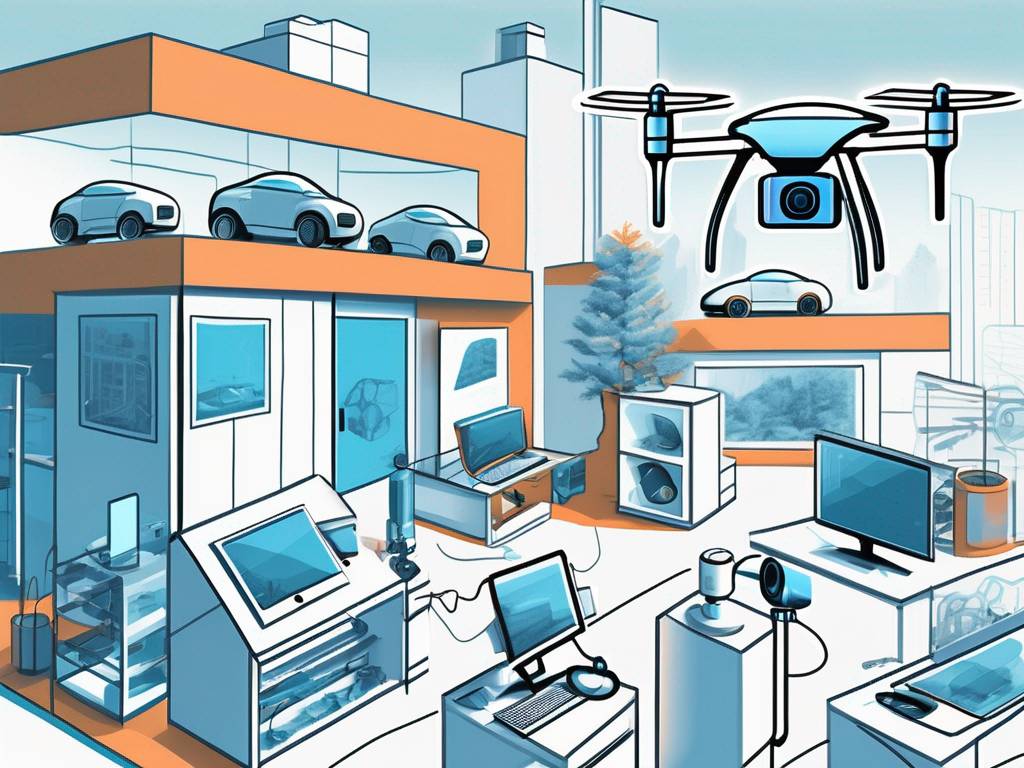Generative AI vs. Predictive AI: Understanding Key Distinctions
Artificial Intelligence (AI) has revolutionized industries across the globe and is rapidly transforming the way we live, work, and interact with technology. Within the realm of AI, two prominent subfields have emerged: Generative AI and Predictive AI. Although these terms are often used interchangeably, it is essential to recognize their fundamental differences.
By delving into the core concepts and applications of Generative AI vs. Predictive AI, we gain a comprehensive understanding of their unique mechanisms and how they will shape the future of AI technology
Defining Artificial Intelligence
Broadly speaking, AI refers to the development and implementation of computer systems capable of simulating human intelligence. These systems are designed to perceive, reason, learn from data, and interact with their environment, enabling them to perform tasks typically requiring human intelligence.
Core Concepts of AI
AI is at the cutting edge of technological innovation, integrating various machine learning approaches to mimic human cognitive processes. Machine learning involves training algorithms on vast datasets to identify patterns and correlations. This capacity for data-driven learning enables AI to address complex challenges by making predictions or decisions based on identified patterns.
Machine learning has also led to the advancement of deep learning, which uses intricate networks of interconnected neurons, known as neural networks, to process and interpret complex data. This breakthrough has been crucial in allowing machines to comprehend images, videos, and audio, enabling them to carry out tasks like image and speech recognition.
Another fundamental aspect of AI is natural language processing (NLP). Through techniques such as sentiment analysis and natural language generation, this technology enables AI systems to comprehend and generate human-like text. Advances in NLP have empowered machines to understand and respond to human commands, engage in conversations, and generate content from written prompts. These developments have broadened the applications of AI in areas such as virtual assistants like Alexa, chatbots, and automated content creation.
The Evolution of AI
The field of AI has seen remarkable advancements since its inception. Initially, it was centered around simple rule-based systems that executed predefined commands. However, the discipline has evolved to focus on developing sophisticated algorithms capable of learning and adapting from data. This evolution has been driven by advancements in computational power and the emergence of various machine learning techniques.
A critical ambition within AI research and development is the pursuit of Artificial General Intelligence (AGI). AGI, a theoretical construct, represents a level of machine intelligence capable of understanding, learning, and applying knowledge across a wide range of scenarios, potentially matching or surpassing human capabilities. An AGI system would possess a variety of cognitive abilities, including reasoning, problem-solving, abstract thought, comprehension of complex ideas, learning from experience, strategic planning, emotional intelligence, and interacting effectively with the environment.
Unveiling Generative AI
From its humble beginnings with rule-based systems to the advanced generative AI models of today, AI has come a long way in simulating human intelligence. Generative AI marks a significant leap forward by focusing on creating new content rather than solely relying on pre-existing data. By analyzing data patterns and structures, these models can generate new, similar types of data, enabling AI to imagine, create, and generate new art, text, and other types of content.
The Mechanism of Generative AI
The foundation of generative AI is built upon a variety of neural network architectures, each selected and utilized based on the specific needs and objectives of the task at hand. These architectures include Variational Autoencoders (VAEs), Generative Adversarial Networks (GANs), and Large Language Models (LLMs).
VAEs learn the intricacies of input data by distilling it into a latent space—a compressed version of the original data that captures its core characteristics. From this compact space, VAEs create new data samples by understanding how the data is spread out or distributed in this simplified form. This capability enables VAEs to not only replicate the intricacy of the input data but also generate diverse outputs with the underlying patterns of the original data.
GANs consist of two components: a generator and a discriminator. The generator is responsible for creating new samples, while the discriminator’s role is to distinguish between real and generated samples. Through an adversarial training process, the generator and discriminator compete against each other, with the generator continuously improving its ability to create realistic samples. GANs are highly effective for creating detailed and lifelike images, enhancing photo realism, and more.
LLMs like ChatGPT represent another significant branch of generative AI models, focused on text generation and language understanding. Trained on extensive textual datasets, these models excel at generating human-like text, capturing language nuances and context. Unlike VAEs and GANs, LLMs predict the next word in a sequence, enabling them to perform a variety of language tasks such as writing, translation, summarization, and conversation. This versatility positions LLMs as a crucial tool in various applications, from education to customer service.
Applications of Generative AI
Generative AI finds applications across various domains, impacting both industry professionals and everyday individuals alike. In the realm of art, generative AI models are creating visually stunning paintings and digital artworks. These AI-generated artworks not only challenge traditional notions of creativity but also provide a fresh perspective on the possibilities of artistic expression. For example, imagine an AI model combining the styles of Vincent Van Gogh, known for his vivid, swirling skies, and Andy Warhol, the iconic American pop artist. The result would be a fascinating blend of Van Gogh’s dynamic brushwork and intense use of color with Warhol’s bold, graphic aesthetic and iconic pop culture references.
The impact of generative AI also extends into music composition, where it is helping artists discover new melodies, harmonies, and rhythms that go beyond what human composers could imagine. Recent projects have seen AI compose pieces in the style of classical composers, yet infused with unique elements that could only arise from an AI’s “mind,” showcasing a thrilling blend of tradition and innovation.
In the field of content creation, generative models are redefining efficiency and personalization. Generative AI tools can draft articles, narratives, and executive summaries, significantly optimizing the content creation pipeline. More impressively, they can adapt to specific user tastes and writing nuances, producing customized content that resonates on a personal level. This advancement not only conserves time and resources but also elevates the user experience, offering content that aligns with individual preferences. Examples of this include AI-generated news articles that adjust tone and complexity based on the reader’s understanding, and personalized story generation that caters to the reader’s interests and mood.
The applications of generative AI are vast and continue to expand. From art and music to content generation, this technology is pushing the boundaries of what AI can achieve. As we delve deeper into the world of generative AI, we uncover new possibilities and unlock the potential for AI to become a true creative partner.
Exploring Predictive AI
Predictive AI, on the other hand, focuses on forecasting and predicting future outcomes based on historical data patterns. By analyzing patterns and trends, predictive AI models enable us to make informed decisions and predictions about future events.
How Predictive AI Works
Predictive AI employs sophisticated algorithms that utilize statistical and machine learning techniques to uncover patterns and relationships within data. These statistical algorithms serve as the foundation for generating precise predictions and insightful forecasts from historical data.
One crucial technique in predictive AI is time series analysis, which examines data collected over time to identify trends, seasonal fluctuations, and other cyclic patterns. By deciphering these patterns, predictive models can accurately predict future values.
Regression algorithms are utilized in predictive analytics to model the relationship between a dependent variable and one or more independent variables. These algorithms aim to identify underlying patterns and trends by fitting a mathematical equation to the data that best describes the relationship between the variables. By analyzing historical data, regression models estimate equation parameters, enabling predictions of the dependent variable’s value based on the independent variables.
Classification algorithms are also integral to predictive AI models, categorizing data into classes based on their characteristics. These algorithms leverage complex decision boundaries to segregate data points into distinct groups, facilitating pattern identification and predictions about future instances. Whether discerning fraudulent transactions or classifying images, classification algorithms enhance predictive capabilities and drive actionable insights in many industries.
Utilization of Predictive AI
Predictive AI has extensive applications across various industries, including finance, healthcare, and marketing. In finance, predictive models analyze historical data, market trends, and relevant factors to forecast stock market trends. This information is invaluable for investors who want to maximize their returns and minimize risks.
In the healthcare industry, predictive AI plays a vital role in diagnosing diseases and predicting patients’ future health outcomes. By analyzing a patient’s medical history, genetic data, and lifestyle factors, predictive AI algorithms can identify patterns indicative of potential diseases. This early detection enables healthcare professionals to proactively intervene, offering personalized treatment plans that enhance patient outcomes.
Marketing is another field where predictive AI is making a significant impact. By analyzing consumer data, including past purchases, browsing behavior, and demographic information, predictive AI empowers targeted advertising campaigns. These campaigns, tailored to individual preferences and behaviors, increase the chances of conversion and customer satisfaction. Predictive AI also helps businesses identify potential high-value customers and optimize their marketing strategies accordingly.
As predictive AI continues to evolve, its applications will only expand. From optimizing crop yields in agriculture to streamlining production processes in manufacturing, this technology has the potential to transform industries and improve decision-making processes.
Key Differences Between Generative & Predictive AI
Discover the fundamental differences between generative and predictive AI through the detailed comparison in the table below.
| Generative AI | Predictive AI | |
| Purpose | Creates new content or data that mimics the learned patterns from its training data. | Predicts future outcomes or trends based on historical and current data analysis. |
| Functionality | Generates new images, text, or sounds by understanding and applying the characteristics of the training dataset. | Uses statistical models to forecast future events or behaviors, providing probabilities or specific outcomes. |
| Data Usage | Requires a large dataset with diverse and quality data to learn the underlying patterns, styles, and features for generating new content. | Focuses on analyzing patterns and correlations within historical data to make predictions about future events. |
| Evaluation | Evaluation combines objective metrics for assessing output quality and diversity, with human judgment for relevance, creativity, and ethics. | Evaluated using metrics such as accuracy, precision, recall, F1-Score, or mean squared error, depending on the specific task. These metrics are critical for validating the model’s reliability and accuracy in real-world scenarios. |
| Outcome | Produces innovative and original content that can expand on existing ideas or create entirely new concepts. | Provides insights, forecasts, and risk assessments. These insights can range from identifying trends to detecting anomalies and optimizing processes. |
| Applications | Content generation, art and design, personalized video content, music production, virtual modeling, synthetic data generation, language translation, voice generation, and other similar tasks. | Risk assessment, demand forecasting, financial analysis, health diagnostics, fraud detection, algorithmic trading, route optimization, customer behavior predictions, and other similar tasks. |
| Examples | DALL-E for image creation and GPT for text generation. | Credit scoring models, weather forecasting systems, predictive maintenance, and sales forecasting tools. |
Impact & Implications
The impact of generative AI lies in its ability to augment human creativity and generate content that would otherwise be unattainable. It offers new possibilities in various creative fields, raising questions about authenticity and authorship. Predictive AI facilitates decision-making and empowers industries with data-driven insights. However, concerns regarding privacy, bias, and ethical implications surrounding the use of predictive models in sensitive domains are also pertinent.
Future Prospects of Generative & Predictive AI
Advancements in Generative AI
Generative AI holds immense potential for further advancements and innovations. Ongoing research focuses on improving the quality and diversity of generated content, as well as addressing challenges such as model collapse and overfitting. Advancements in generative AI are anticipated to enhance human-computer interactions, revolutionize content creation, and unlock new frontiers in artistic expression.
Progress in Predictive AI
Predictive AI is expected to continue reshaping industries by delivering increasingly accurate predictions and insights. Advancements in areas such as interpretable machine learning and explainable AI aim to address the black-box nature of predictive models, making them more transparent and understandable. The integration of predictive AI with other technologies, such as the Internet of Things (IoT) and Big Data analytics, opens up new avenues for data-driven decision-making and intelligent systems.
Conclusion
Generative AI and predictive AI are two distinct subfields of Artificial Intelligence with different purposes and mechanisms. Generative AI focuses on creative content generation, while predictive AI aims to forecast future outcomes using historical data. As we explore the capabilities of these technologies, ensuring their ethical and responsible use is essential. Balancing innovation with ethical considerations is crucial for maximizing AI’s potential. By understanding the key distinctions between these two subfields, we can harness their unique capabilities and leverage them to drive innovation and shape the future of AI technology.
Questions?
- What is generative AI?Toggle questionGenerative AI is a category of artificial intelligence that focuses on creating new content, such as images, text, or even music. This capability is based on learning from a vast amount of data. Unlike traditional AI, which is designed to understand or interpret information, generative AI focuses on the creation of new, original outputs that did not previously exist.
- What is predictive AI?Toggle questionPredictive AI aims to make predictions about future outcomes based on historical data. It analyzes patterns to forecast trends, behaviors, or events, offering valuable insights for decision-making.
- What are the primary applications of generative AI?Toggle questionGenerative AI finds applications in creative fields, including art generation, content creation, and even generating realistic text. It's employed in scenarios where the goal is to produce novel and diverse outputs.
- In which industries is predictive AI commonly used?Toggle questionPredictive AI is extensively used in industries like finance, healthcare, marketing, and logistics. It helps in risk assessment, demand forecasting, personalized recommendations, and optimizing operational processes.
- Can generative AI be used for practical, real-world applications?Toggle questionYes, generative AI has practical applications. For instance, it can be used to create realistic simulations for training purposes, design prototypes, or even generate synthetic data for testing machine learning models.
- How does WestLink approach generative AI development?Toggle questionWestLink combines expertise in AI and deep learning to create tailored Generative AI solutions. We work closely with clients to understand their specific requirements and leverage the latest technologies for effective implementation.
- Can a single AI model be both generative and predictive?Toggle questionWhile some AI models may exhibit aspects of both, they typically lean toward one category. Generative models emphasize creativity, while predictive models focus on forecasting. The choice depends on the intended application.
- What are the ethical considerations of generative and predictive AI?Toggle questionThe ethical considerations of generative and predictive AI include addressing bias in training data to prevent discriminatory outcomes, ensuring privacy and informed consent in the use of personal data, clarifying accountability and responsibility for AI decisions, navigating intellectual property rights in AI-generated content, and safeguarding against the malicious use of AI technologies.

 hello@westlink.com
hello@westlink.com  (866) 954-6533
(866) 954-6533  700 N Colorado Blvd,
700 N Colorado Blvd,








Comments